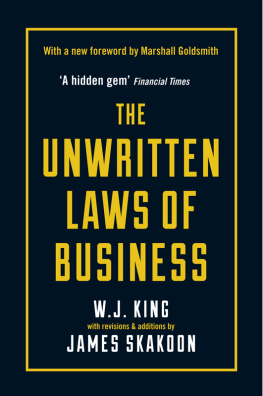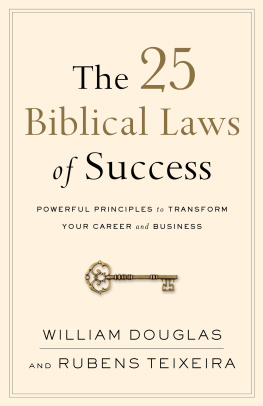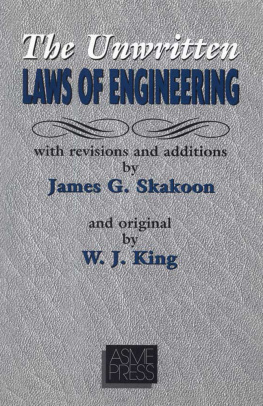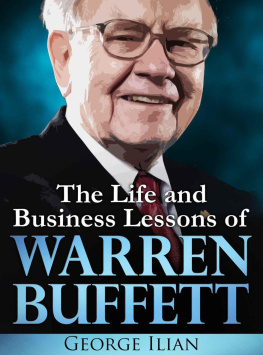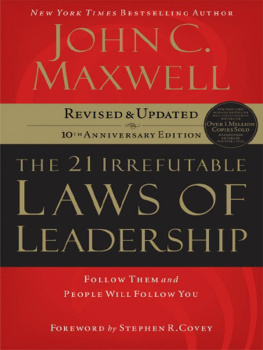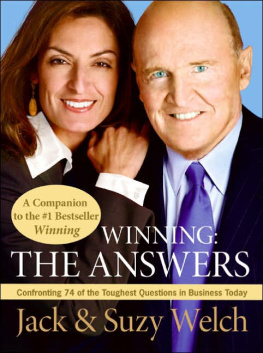THE UNWRITTEN LAWS OF BUSINESS

W. J. KING
WITH REVISIONS AND ADDITIONS BY
JAMES G. SKAKOON

This edition published in 2014
First published in Great Britain in 2007 by
PROFILE BOOKS LTD
3A Exmouth House
Pine Street
London ECIR 0JH
www.profilebooks.com
First published in the United States in 2007 by
Doubleday, an imprint of The Doubleday Broadway Publishing Group, a division of Random House, Inc., New York. www.currencybooks.com
This book was originally published in a revised edition in 2001 by the American Society of Mechanical Engineers under the title The Unwritten Laws of Engineering.
Copyright The American Society of Mechanical Engineers, 2007, 2008, 2014
Information contained in this work has been obtained by the American Society of Mechanical Engineers from sources believed to be reliable. However, neither ASME nor its authors or editors guarantee the accuracy or the completeness of any information published in this work. Neither ASME nor its authors or editors shall be responsible for any errors, omissions, or damages arising out of the use of this information. The work is published with the understanding that ASME and its authors and editors are supplying information but are not attempting to render engineering or other professional services. If such engineering or professional services are required, the assistance of an appropriate professional should be sought.
The moral right of the authors has been asserted.
All rights reserved. Without limiting the rights under copyright reserved above, no part of this publication may be reproduced, stored or introduced into a retrieval system, or transmitted, in any form or by any means (electronic, mechanical, photocopying, recording or otherwise), without the prior written permission of both the copyright owner and the publisher of this book.
A CIP catalogue record for this book is available from the British Library.
eISBN 978 1 84765 666 7
FOREWORD
Every day we see examples of business leaders who have successfully reached the top. Ive met a lot of these leaders in my work as a speaker and executive coach. Even working closely with them, it can still be hard to connect the place theyve arrived at with the road they took to get there. How do we know that what theyre doing now is whats taken them to such heights? Sometimes, as you know if youve read What Got You Here Wont Get You There, even the best leaders have bad habits!
Of course every industry is differentas is every person (and every leader). But what all successful leaders have in common is a well-defined sense of where theyre going and how. The Unwritten Laws of Business helps you to answer the how.
First written in 1944 and distributed only to a select few, its recent transformation into a bestseller is a testament to the wealth of hard-earned wisdom it containswisdom that not even the best managers achieve on their own. As well as practical, common sense rules for people just starting out on their careers there are helpful reminders of the simple things even the most experienced of us forget from time to time.
The Unwritten Laws are built around a timeless code of workplace conduct that will make you a more effective worker and leader, and help you stand out as someone people admire and respect. But they are about the destination too, because its the how that will get you (back) on trackonwards and upwards. Imagine a world where everyone is blessed with equal talent and opportunities. How would you distinguish yourself from others? Chances are youve come to the same answer I did: its the way you conduct yourself that stands out.
Business leaders may seem to have reached the very top based on their talent alone, but in reality they graduated alongside a dozen people just as talented and just as driven to succeed. Its not enough to be smart. You have to be smartand something else. That something else is exactly what these Unwritten Laws are all about.
Life is good.
Marshall Goldsmith
PREFACE
When I was first updating an earlier edition of this book, which was written with engineers in mind, people reviewing my drafts remarked that its advice applies to anyone in the workplace, and not only to its intended audience. It was first published in 1944 as The Unwritten Laws of Engineering, and has been available ever since, but mostly to engineers and engineering managers. Some readers suggested that the book should be extensively rewritten for a broader audience. Nevertheless, in 2001 we decided to update it without changing its scope and its unique style.
Although I revised substantial portions of this book in 2001, I tried to make my changes as unnoticeable as possible. Most revisions were in response to shifts in societal values, employment laws, and corporate structures, all of which had evolved over time. I offer no apology for omitting references to the latest technology (e-mail, computers, Internet): the books advice transcends the mere implements of the workplace. Although some words and phrases were changed for being painfully archaic, many of the old-fashioned words remainthey add to the fun.
What I did not fully understand about Unwritten Laws until recently is that it is suitable for anyone in business largely as it is. There was no need for extensive revisions for the rules to appeal to a wider audience. Apart from replacing engineers with businesspeople, this trade edition is only modestly changed from its predecessor.
What I did understand upon first reading this book, along with how fun it was to read, was how well it has held up over the decades. Most of the advice from the 1944 version is still relevant today. I hope this edition retains this timelessness and is enjoyable to read, my efforts notwithstanding, in another six decades.
I would like to acknowledge Mary Grace Stefanchik, the ASME Press book-publishing manager, for entrusting me with updating this classic book, and W. J. King, the original author, for writing it.
James G. Skakoon
INTRODUCTION
Prior to writing the first text of this book, the originating author admitted to having become very much aware that in any organization the chief obstacles to success are of a personal and administrative nature. It was apparent that both he and his associates were getting into much more trouble by violating the undocumented laws of professional conduct than by committing sins or errors relating directly to their work. With suitable laws appearing to be unwritten at that time, laws were formulated and collected into a scrapbook as a professional code of sorts. Although they were, and in this latest edition still are, fragmentary and incomplete, they are offered here for whatever they may be worth to younger businesspeople just starting their careers, and to older ones who know these things perfectly well but who all too often fail to apply them.
None of these laws is theoretical or imaginary, and however obvious they may appear, their repeated violation is responsible for much of the frustration and embarrassment to which employees and managers everywhere are liable. In fact, the first edition of this book was primarily a record derived from direct observation over 17 years of four different departments, three of them newly organized and struggling to establish themselves by trial-and-error. It has been confirmed by the experience of others as gathered from numerous discussions, observations, and literature, so that it most emphatically does not reflect the unique experience or characteristics of any one organization.
Next page
